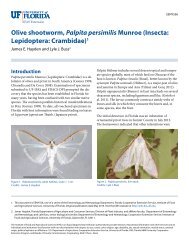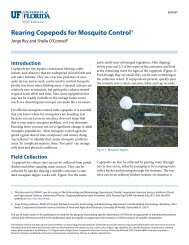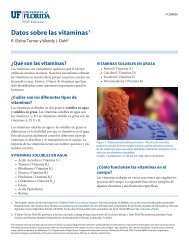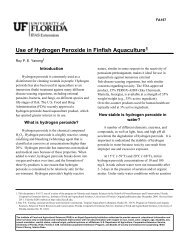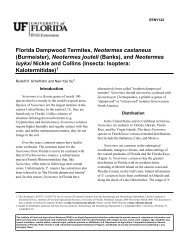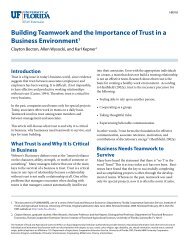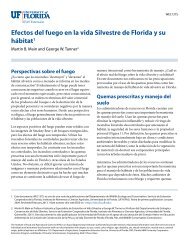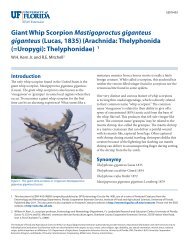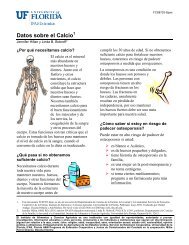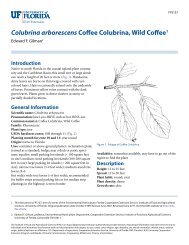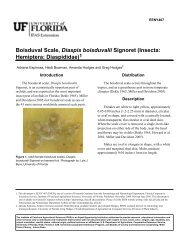Florida Coonties and Atala Butterflies - EDIS - University of Florida
Florida Coonties and Atala Butterflies - EDIS - University of Florida
Florida Coonties and Atala Butterflies - EDIS - University of Florida
Create successful ePaper yourself
Turn your PDF publications into a flip-book with our unique Google optimized e-Paper software.
<strong>Florida</strong> <strong>Coonties</strong> <strong>and</strong> <strong>Atala</strong> <strong>Butterflies</strong> 1<br />
Daniel F. Culbert 2<br />
Sunshine State gardeners have rediscovered the<br />
<strong>Florida</strong> coontie (Figure 1) as a native plant well<br />
adapted to <strong>Florida</strong> yards. Its increased use in<br />
l<strong>and</strong>scapes has encouraged the presence <strong>of</strong> the rare<br />
atala butterfly, which uses coontie as a larval host<br />
plant. L<strong>and</strong>scapers <strong>and</strong> homeowners can encourage<br />
either the plant or the butterfly by following the<br />
suggestions in this publication.<br />
Figure 1. <strong>Coonties</strong> are a desirable native plant for <strong>Florida</strong><br />
l<strong>and</strong>scapes. (Photo: Dan Culbert, UF/IFAS)<br />
Coontie Relatives<br />
ENH117<br />
The coontie, an unusual <strong>Florida</strong> native, is a<br />
cycad—a "living fossil." These primitive plants were a<br />
dominant form <strong>of</strong> plant life during the dinosaur age.<br />
Other introduced cycads commonly grown in <strong>Florida</strong><br />
are:<br />
• Cardboard plant/Mexican zamia (Zamia<br />
furfuracea)<br />
http://hort.ifas.ufl.edu/shrubs/zamfura.pdf<br />
• King sago (Cycas revoluta)<br />
http://hort.ifas.ufl.edu/shrubs/cycrev.pdf<br />
• Queen sago (Cycas rumphii) (Previously called<br />
C. circinalis.) http://edis.ifas.ufl.edu/FP161<br />
Coontie Species. There are many different<br />
opinions as to the correct name <strong>of</strong> the species <strong>of</strong><br />
coontie found growing in <strong>Florida</strong>. The predominant<br />
taxonomic opinion is that there is a single coontie<br />
species in <strong>Florida</strong> (Zamia floridana), while others<br />
feel the coontie is represented by several species.<br />
Other species names proposed by one or more<br />
botanists for the <strong>Florida</strong> coontie include Z.<br />
integrifolia, Z. pumila, <strong>and</strong> Z. umbrosa. Z. pumila is<br />
1. This document is Fact Sheet ENH 117, a series <strong>of</strong> the Environmental Horticulture Department, <strong>Florida</strong> Cooperative Extension Service, Institute <strong>of</strong> Food<br />
<strong>and</strong> Agricultural Sciences, <strong>University</strong> <strong>of</strong> <strong>Florida</strong>. Original publication date, October 1995. Revised March 2010.<br />
2. Daniel F. Culbert, county extension agent III, Okeechobee, FL, Cooperative Extension Service, Institute <strong>of</strong> Food <strong>and</strong> Agricultural Sciences, <strong>University</strong> <strong>of</strong><br />
<strong>Florida</strong><br />
The use <strong>of</strong> trade names in this publication is solely for the purpose <strong>of</strong> providing specific information. It is not a guarantee or warranty <strong>of</strong> the products named<br />
<strong>and</strong> does not signify that they are approved to the exclusion <strong>of</strong> others <strong>of</strong> suitable composition.<br />
The Institute <strong>of</strong> Food <strong>and</strong> Agricultural Sciences (IFAS) is an Equal Opportunity Institution authorized to provide research, educational information <strong>and</strong><br />
other services only to individuals <strong>and</strong> institutions that function with non-discrimination with respect to race, creed, color, religion, age, disability, sex,<br />
sexual orientation, marital status, national origin, political opinions or affiliations. U.S. Department <strong>of</strong> Agriculture, Cooperative Extension Service,<br />
<strong>University</strong> <strong>of</strong> <strong>Florida</strong>, IFAS, <strong>Florida</strong> A. & M. <strong>University</strong> Cooperative Extension Program, <strong>and</strong> Boards <strong>of</strong> County Commissioners Cooperating. Millie<br />
Ferrer-Chancy, Interim Dean
<strong>Florida</strong> <strong>Coonties</strong> <strong>and</strong> <strong>Atala</strong> <strong>Butterflies</strong> 2<br />
the name <strong>of</strong> a species found growing in the<br />
Dominican Republic; however, it is <strong>of</strong>ten used in the<br />
nursery trade as the botanical name for coontie.<br />
Subtle differences in leaflet size <strong>and</strong> shape, in<br />
addition to differences in the native ranges in the<br />
state, have been used by some botanists to delineate<br />
up to four different ecotypes <strong>of</strong> coontie (Figure 2).<br />
Figure 2. <strong>Florida</strong> coontie leaflet shapes <strong>and</strong> ranges. (Data<br />
from Broome 2006.)<br />
Habitat <strong>and</strong> Range<br />
The coontie is native to most <strong>of</strong> peninsular<br />
<strong>Florida</strong> <strong>and</strong> southeastern Georgia east <strong>of</strong> the<br />
Apalachicola River (Figure 3). None <strong>of</strong> the <strong>Florida</strong><br />
native species are known in the West Indies, but<br />
related Zamia species are found there. Its natural<br />
habitat is dominated by pines <strong>and</strong> well-drained,<br />
s<strong>and</strong>y, or loamy soils. USDA hardiness zones for the<br />
coontie are between 8B <strong>and</strong> 11, which means it<br />
should survive a minimum winter temperature <strong>of</strong><br />
15°F.<br />
The coontie was once a common plant in <strong>Florida</strong><br />
hammocks <strong>and</strong> pinel<strong>and</strong>s, but because <strong>of</strong> intensive<br />
collection for starch production <strong>and</strong> l<strong>and</strong>scape use, it<br />
is not commonly seen in the wild. The coontie is<br />
included in <strong>Florida</strong>'s Commercially Exploited Plant<br />
List [FDACS/DPI rule 5B-40.0055 (c)]. Collection <strong>of</strong><br />
the coontie from the wild is prohibited.<br />
Description<br />
Foliage. This herbaceous plant looks like a small<br />
fern or palm. Typically they are 1–3 ft. high (Figure<br />
4), while forms in the Ocala National Forest can be<br />
Figure 3. Native range for Zamia floridana. (Data from<br />
Wunderlin <strong>and</strong> Hansen 2008.)<br />
as much as 4–5 ft. tall. The coontie has stiff,<br />
featherlike leaves, up to 3 ft. in length, which are<br />
attached to a thick, shortened stem. New leaves<br />
uncurl from the top <strong>of</strong> this stem. The thickened<br />
underground rootlike structure is called a caudex<br />
(Figure 7) <strong>and</strong> can be branched multiple times.<br />
Coontie leaves have slender leaflets, 3–6 in. long<br />
<strong>and</strong> attached like the pinnae <strong>of</strong> a feather along the<br />
stalk (rachis). The dark green leaflets are stiff <strong>and</strong><br />
glossy.<br />
Figure 4. Several coonties in the l<strong>and</strong>scape <strong>of</strong> Selby<br />
Botanical Gardens, Sarasota. (Photo: Dan<br />
Culbert,UF/IFAS)<br />
Flowers <strong>and</strong> Fruit. This primitive plant is<br />
dioecious; thus, plants are either male or female <strong>and</strong><br />
produce male or female cones. The sex <strong>of</strong> young<br />
plants cannot be determined until the cones form on<br />
the mature plants. Slender male cones are 3–7 in. tall
<strong>Florida</strong> <strong>Coonties</strong> <strong>and</strong> <strong>Atala</strong> <strong>Butterflies</strong> 3<br />
<strong>and</strong> produce pollen (Figure 5). Upright brown female<br />
cones (Figure 6) are about 6 in. tall <strong>and</strong> are covered<br />
with velvety fuzz. At maturity, the cones <strong>of</strong> the<br />
female plant will crumble open to reveal angular or<br />
lobed seeds with an orange red waxy-looking, fleshy<br />
coating called the sarcotesta.<br />
Figure 5. Male cones (strobilus) <strong>of</strong> coontie are thinner <strong>and</strong><br />
shorter than female cones. (Photo: Dan Culbert, UF/IFAS)<br />
Figure 6. Female (megasporangiate) cone <strong>of</strong> coontie.<br />
Upon maturity, the cone falls apart, revealing individual<br />
"seeds" covered with fleshy orange skin. (Photo: Dan<br />
Culbert, UF/IFAS)<br />
Nonl<strong>and</strong>scape Uses<br />
Native Food Source. Spanish writings from the<br />
sixteenth century report that the original native<br />
Timucuan <strong>and</strong> Calusa people removed the toxic<br />
chemical, cycasin, from the coontie stem (Figure 7)<br />
by maceration <strong>and</strong> washing. They then used the<br />
starchy residue to produce a bread. This was an<br />
important food source that sustained them throughout<br />
most <strong>of</strong> the year.<br />
Figure 7. The coontie's underground stem is more<br />
properly called a caudex. It contains both starch <strong>and</strong> a<br />
water soluble toxin. (Photo: Stephen Brown, UF/IFAS Lee<br />
County)<br />
The Seminole Indians learned this process from<br />
the Timucuan <strong>and</strong> Calusa natives they displaced. The<br />
common name, "coontie," is derived from the<br />
Seminole phrase "conti hateka," which means white<br />
root or white bread. Another name for the coontie is<br />
"Seminole bread." The Seminoles also used the<br />
starchy stem to make another dish called "s<strong>of</strong>kee<br />
stew."<br />
Starch Industry. Around 1825, early settlers in<br />
the Fort Lauderdale area learned the Seminole's<br />
technique <strong>of</strong> removing the toxin cycasin from the<br />
coontie to produce starch. By the 1880s, several mills<br />
were in business in Miami. During WWI, one mill<br />
was processing as much as 18 tons <strong>of</strong> coontie daily<br />
for military purchase. The starch content was said to<br />
range from 20% in winter to a low <strong>of</strong> 8% in summer.<br />
By 1911, the starch was known as "<strong>Florida</strong><br />
Arrowroot."<br />
Florist Greens. Florists sometimes use coontie<br />
leaves as greenery in floral arrangements. The foliage<br />
provides tropical appeal in arrangements <strong>and</strong> has the<br />
ability to last as a cut green. Cut foliage is bunched<br />
<strong>and</strong> shipped from local sources to florists.
<strong>Florida</strong> <strong>Coonties</strong> <strong>and</strong> <strong>Atala</strong> <strong>Butterflies</strong> 4<br />
L<strong>and</strong>scape Characteristics <strong>and</strong><br />
Uses<br />
Coontie's high drought <strong>and</strong> moderate salt<br />
tolerance make it an excellent choice as a<br />
low-maintenance l<strong>and</strong>scape plant for coastal <strong>Florida</strong>.<br />
The coontie can be planted in a variety <strong>of</strong> light<br />
conditions, from deep shade to full sun. Well-drained<br />
soils are needed, <strong>and</strong> a small amount <strong>of</strong> organic<br />
material will enhance growth. It may be used as a<br />
specimen, a foundation planting, or as a massed<br />
planting for groundcover. When used for<br />
groundcover, space the plants 12–20 in. apart. Do<br />
not plant them where foot traffic is likely to occur.<br />
Because it is illegal to collect these plants from<br />
the wild, plants used for l<strong>and</strong>scape purposes are<br />
nursery grown. The natural taproot is easily damaged<br />
when these cycads are transplanted from natural<br />
areas.<br />
Propagation<br />
Seed Collection. Seeds from the coontie are<br />
slow to germinate, <strong>and</strong>, when they do, the plant grows<br />
slowly. A nursery-raised plant may take five years to<br />
reach marketable size. This is why coonties are<br />
expensive <strong>and</strong> sometimes difficult to locate in<br />
nurseries. Established plantings provide seed for<br />
propagation. Artificial pollination may improve seed<br />
set because male <strong>and</strong> female cones may not be<br />
receptive at the same time. Successful germination is<br />
accomplished by collecting the crumbled female<br />
cones.<br />
Seed Preparation. The orange red, fleshy<br />
covering—the sarotesta—must be removed, as it<br />
contains germination inhibitors. Some nursery<br />
workers float the seeds in water <strong>and</strong> pour <strong>of</strong>f the<br />
floating, nonviable seeds. It has also been suggested<br />
that rattling seeds may have reduced viability.<br />
To speed germination, the thick, stony layer—the<br />
sclerotesta—may be scarified by mechanical means<br />
(e.g., filing) or by chemical treatment (one hour <strong>of</strong><br />
sulfuric acid followed by two days <strong>of</strong> gibberellic acid<br />
to initiate embryo growth).<br />
Planting. Seeds should be covered with a thin layer<br />
<strong>of</strong> soil. Within six weeks <strong>of</strong> sprouting, seedlings are<br />
transplanted to containers.<br />
<strong>Coonties</strong> with a single taproot may become pot<br />
bound in containers. These plants will be more<br />
difficult to establish in the l<strong>and</strong>scape than those with<br />
more fibrous root systems. Dr. Bijan Dehgan<br />
developed a procedure to modify the taproot into a<br />
branching root system. Experienced nursery growers<br />
can consult his methods as noted in the references.<br />
Soil <strong>and</strong> Fertilizer. Natural conditions for<br />
coonties indicate a need for well-drained soil. A<br />
successful soilless media for container production has<br />
been suggested as follows: one part Metro-Mix 500<br />
(W. R. Grace Co.) or similar mix, one part sharp<br />
s<strong>and</strong>, one part perlite, one part pine bark, 5 lbs. <strong>of</strong><br />
Dolomite, <strong>and</strong> 3 lbs. <strong>of</strong> Perk micronutrient per cubic<br />
yard.<br />
Cyanobacteria (blue green bacteria) are known<br />
to associate with surface (apogeotropic or coralloid)<br />
roots <strong>of</strong> Zamia, allowing it to grow in poor soil<br />
conditions. These symbiotic organisms have the<br />
ability to take nitrogen from the air <strong>and</strong> change it into<br />
nitrogen nutrients. Using nitrate nitrogen fertilizer<br />
reduces the effectiveness <strong>of</strong> symbiosis, while<br />
ammoniacal forms encourage the uptake <strong>of</strong> nitrogen<br />
into the cycads. In the wild, a soil pH <strong>of</strong> 6.0 or more<br />
has been noted in locations with dense, healthy<br />
coontie plants.<br />
Coontie Pest Management<br />
<strong>Coonties</strong> have adapted to the natural<br />
environment <strong>of</strong> <strong>Florida</strong> over several thous<strong>and</strong> years.<br />
Weeds are best controlled by mulching around the<br />
coontie plants to prevent turf or other plants from<br />
competing with this slow-growing native. However,<br />
do not allow mulch to lie in contact with the crown,<br />
as this may encourage rot. Diseases have been noted<br />
in cases <strong>of</strong> excessive irrigation.<br />
Some <strong>of</strong> the very few significant insect pests<br />
common to coontie are <strong>Florida</strong> red scale<br />
(Chrysomphalus aonidum) <strong>and</strong> hemispherical scales<br />
(Saissetia c<strong>of</strong>feae) (Figure 8). Damage to coontie<br />
leaves by scale feeding may result in irregular yellow<br />
patches on the leaves (Figure 9). Mealybugs, such as
<strong>Florida</strong> <strong>Coonties</strong> <strong>and</strong> <strong>Atala</strong> <strong>Butterflies</strong> 5<br />
the longtailed mealybug (Pseudococcus longispinus),<br />
also are found on l<strong>and</strong>scape coonties (Figure 10).<br />
These sap-feeding insects encourage the development<br />
<strong>of</strong> sooty mold (Figure 11). Mealybug destroyers<br />
(Cryptolaemus montrouzeri) are <strong>of</strong>ten seen on<br />
coonties, feeding on red scale. They look similar to<br />
mealybugs (Figure 12).<br />
All <strong>of</strong> these pests can be controlled with<br />
insecticidal soaps or other contact insecticides.<br />
Identify any predators before using chemical<br />
insecticides to reduce pest populations. Check with<br />
your county Extension <strong>of</strong>fice for the latest chemical<br />
pesticide recommendations.<br />
Figure 8. <strong>Florida</strong> red scales <strong>and</strong> hemispherical scales.<br />
(Photo: Lyle Buss, UF/IFAS)<br />
Figure 9. Damage to coontie leaf due to scale insects.<br />
(Photo: Lyle Buss, UF/IFAS)<br />
<strong>Atala</strong> Butterfly<br />
The coontie serves as the sole host plant for<br />
larvae <strong>of</strong> the rare atala butterfly (Eumaeus atala),<br />
once thought to be extinct in <strong>Florida</strong> (Figure 13). The<br />
hungry larvae are able to withst<strong>and</strong> the coonties'<br />
natural toxins <strong>and</strong>, in turn, incorporate them into their<br />
tissues, rendering the larvae <strong>and</strong> adults unpalatable to<br />
Figure 10. Longtailed mealybugs on cycad leaf. (Photo:<br />
Lyle Buss, UF/IFAS)<br />
Figure 11. The leaves <strong>of</strong> this coontie are covered with<br />
black sooty mold, a result <strong>of</strong> a heavy insect infestation.<br />
(Photo: Dan Culbert, UF/IFAS)<br />
Figure 12. Mealybug (L) being consumed by mealybug<br />
destroyer (R). (Photo: Sonya Broughton, Department <strong>of</strong><br />
Agriculture & Food Western Australia, Bugwood.org)<br />
various predators, particularly birds. The bright colors<br />
<strong>of</strong> the larvae <strong>and</strong> adult butterflies (Figure 14) warn<br />
predators that they are toxic.<br />
Range. The atala has been reported in <strong>Florida</strong><br />
from Dade County north into Martin County.<br />
Documented reports <strong>of</strong> atala also have come from<br />
Pinellas County (Figure 15). In 1993, this butterfly
<strong>Florida</strong> <strong>Coonties</strong> <strong>and</strong> <strong>Atala</strong> <strong>Butterflies</strong> 6<br />
Figure 13. Adult atala butterflies. (Photo: Dan Culbert,<br />
UF/IFAS)<br />
Figure 14. Dorsal (top) side <strong>of</strong> atala wings. (Photo: Jerry<br />
Butler, UF/IFAS)<br />
was sighted in St. Lucie <strong>and</strong> Indian River counties.<br />
The exp<strong>and</strong>ed presence <strong>of</strong> atala butterflies can be<br />
attributed to the increased use <strong>of</strong> coonties in the<br />
l<strong>and</strong>scape. Nursery-grown coonties that originate<br />
from more southern locations have been a source <strong>of</strong><br />
atalas in other areas <strong>of</strong> <strong>Florida</strong>.<br />
Figure 15. Range map <strong>of</strong> atala in <strong>Florida</strong>. (Adapted from<br />
USGS Northern Prairie Wildlife Research Center.)<br />
Description. A single female may produce<br />
several dozen eggs during her life. The yellow white<br />
eggs (Figure 16) are deposited on new growth or near<br />
the tip <strong>of</strong> mature leaflets. Eggs also have been found<br />
to be deposited on the female coontie cones (Figure<br />
17). The eggs are deposited singly or in clusters <strong>of</strong><br />
5–15 eggs.<br />
Figure 16. <strong>Atala</strong> egg cluster on coontie foliage. (Photo:<br />
Dan Culbert, UF/IFAS)<br />
Figure 17. This cluster <strong>of</strong> atala eggs on a female<br />
(megasporangiate) cone shows a newly hatched larva.<br />
(Photo: Dan Culbert, UF/IFAS)<br />
<strong>Atala</strong> caterpillars, or larvae (Figure 18), are<br />
orange red with seven pairs <strong>of</strong> yellow spots running<br />
along the back (dorsal side). These larvae will reach<br />
up to 1.25 in. long at maturity. The resulting orange<br />
<strong>and</strong> brown pupae (chrysalises) (Figure 19) are<br />
approximately 1 in. long <strong>and</strong> hang from a silken<br />
girdle under coontie leaflets.<br />
Figure 18. Larva (caterpillar) <strong>of</strong> atala butterfly. (Photo:<br />
Jerry Butler, UF/IFAS)
<strong>Florida</strong> <strong>Coonties</strong> <strong>and</strong> <strong>Atala</strong> <strong>Butterflies</strong> 7<br />
Figure 19. Several pupae <strong>of</strong> atala suspended under a<br />
coontie leaflet. Note cast skin <strong>of</strong> caterpillar on leaf. (Photo:<br />
Dan Culbert, UF/IFAS)<br />
The adult butterfly (see Figure 13) has a<br />
wingspan <strong>of</strong> up to 1.5 in., with its velvety black wings<br />
roughly oval in shape. This butterfly holds its wings<br />
together while at rest, <strong>and</strong> the undersides can be<br />
easily observed. Metallic blue spots on the hind wing<br />
are arranged in three b<strong>and</strong>s. There is an orange red<br />
spot on the underside <strong>of</strong> the hind wing adjacent to the<br />
abdomen, which also is orange red in color. The head<br />
<strong>and</strong> thorax are black. Blue b<strong>and</strong>s also occur on the<br />
dorsal (top) side <strong>of</strong> the hind wing (Figure 14). Males<br />
have greenish patches on the front wing <strong>and</strong> top <strong>of</strong> the<br />
hind wing margins. Females have bluish patches<br />
across the top <strong>of</strong> the forewing.<br />
Life Cycle. Eggs <strong>of</strong> the atala typically hatch in<br />
four to five days. Like all butterflies, they go through<br />
a four-part life cycle (Figure 20). Younger larvae are<br />
typically gregarious, but <strong>of</strong>ten become solitary as<br />
they mature. The larvae are known to be cannibalistic,<br />
especially in captivity.<br />
Figure 20. Life cycle <strong>of</strong> the atala butterfly. (Graphic:<br />
Bonnie Pattock, formerly UF/IFAS FMEL)<br />
Larval development lasts approximately 18 days.<br />
At the end <strong>of</strong> this period, the larva will stop feeding,<br />
remain stationary, hunch up <strong>and</strong> attach itself to a<br />
frond, <strong>and</strong> finally molt into the pupa (chrysalis).<br />
The pupal stage lasts about 10 days, but is very<br />
temperature dependent. Prior to the emergence <strong>of</strong> an<br />
adult, the outer shell <strong>of</strong> the pupa becomes opaque <strong>and</strong><br />
the dark wings <strong>of</strong> the butterfly become more visible.<br />
The butterfly exhibits a weak, erratic flight <strong>and</strong><br />
travels close to the ground. Courtship <strong>and</strong> mating<br />
occur in late afternoon. Adults may live for one or<br />
more weeks.<br />
All life stages have been observed in every<br />
month, so continuous activity is possible through all<br />
seasons <strong>of</strong> the year. <strong>Atala</strong> have survived a<br />
temperature <strong>of</strong> 29°F (-1.7°C). The exact number <strong>of</strong><br />
generations per year is variable.<br />
Legal Status<br />
At present, the atala is not listed at the state or<br />
federal level. It is, however, identified in <strong>Florida</strong>'s<br />
Comprehensive Wildlife Conservation Strategy as a<br />
"Species <strong>of</strong> Greatest Conservation Need."<br />
Nonetheless, it remains rare <strong>and</strong> <strong>of</strong>ten quite local<br />
throughout its reduced range in <strong>Florida</strong>.<br />
Continued habitat loss <strong>and</strong> alteration make this<br />
insect vulnerable to extinction, but no special permit<br />
is required at this time for either control or collecting<br />
purposes.<br />
<strong>Atala</strong> Management<br />
The atala <strong>of</strong>ten experiences boom <strong>and</strong> bust years.<br />
Some sites may experience high numbers <strong>of</strong><br />
organisms, which can render some plants unsightly<br />
(Figure 21). Voracious atala larvae can defoliate<br />
coonties in weeks (Figure 22). While insect control<br />
may be desired in some locations, the atala larvae<br />
inflict only minimal <strong>and</strong> temporary damage to the<br />
coontie plant. The plants will quickly recover.<br />
Whenever possible, atala management programs<br />
should first involve collection from unwanted sites<br />
<strong>and</strong> relocation to other repository sites, preferably on<br />
conservation l<strong>and</strong>s. The presence <strong>of</strong> adults <strong>and</strong><br />
immature stages <strong>of</strong>ten serves as an ideal opportunity
<strong>Florida</strong> <strong>Coonties</strong> <strong>and</strong> <strong>Atala</strong> <strong>Butterflies</strong> 8<br />
for public interpretation, particularly in parks,<br />
botanical gardens, zoos, or nature centers.<br />
Figure 21. Damage to coontie plants from atala caterpillar<br />
feeding. (Photo: Dan Culbert, UF/IFAS)<br />
Figure 22. Closeup <strong>of</strong> coontie foliage showing superficial<br />
<strong>and</strong> consumptive feeding damage from atala caterpillars.<br />
(Photo: Dan Culbert, UF/IFAS)<br />
Application <strong>of</strong> Pesticides. Little research has<br />
been done to verify effective control <strong>of</strong> this<br />
caterpillar. Chemical insecticides may be effective<br />
based on their use on other caterpillars. Most<br />
caterpillars can be controlled by spraying with<br />
Bacillus thuringensis (Bt) products, such as Dipel <strong>and</strong><br />
Thuricide. These are bacterial spores that produce a<br />
toxin in the stomach <strong>of</strong> the caterpillar <strong>and</strong> provide<br />
specific control for most forms <strong>of</strong> caterpillars.<br />
One trial (Culbert 1994) showed no difference<br />
between different forms <strong>of</strong> Bt products, but use <strong>of</strong><br />
these materials did result in reduced atala caterpillar<br />
populations.<br />
Contemporary approaches to pest control suggest<br />
that a variety <strong>of</strong> methods be used. The concept <strong>of</strong><br />
integrated pest management (IPM) is to use a variety<br />
<strong>of</strong> control measures to keep pest populations below<br />
acceptable levels <strong>of</strong> damage. Because <strong>of</strong> the unusual<br />
nature <strong>of</strong> the atala butterfly, an IPM approach,<br />
including relocation <strong>of</strong> this insect, is suggested.<br />
<strong>Atala</strong> Gardening<br />
Relocation to Butterfly Gardens. When this<br />
insect causes unwanted damage to l<strong>and</strong>scape<br />
coonties, an alternative to insecticidal applications<br />
can be attempted. Before other means <strong>of</strong> control are<br />
initiated, the atala's eggs, larvae, or pupae may be<br />
relocated to another site. Butterfly gardeners can<br />
encourage atala, but only at the expense <strong>of</strong> the<br />
coontie's appearance. Consider neighbors whose<br />
coonties may also be affected by atala from your<br />
butterfly garden.<br />
Interested persons may wish to contact botanical<br />
gardens, conservation groups, or their county<br />
Extension <strong>of</strong>fice for assistance in relocating an<br />
unwanted colony or in establishing the atala as part <strong>of</strong><br />
a butterfly garden.<br />
Environmental Requirements for the <strong>Atala</strong>.<br />
As the atala is a neotropical butterfly, its range is<br />
limited by cold temperatures. Expect a killing frost to<br />
eliminate or reduce the insect population. Because<br />
cold temperatures are moderated by large bodies <strong>of</strong><br />
water, successful sites in more northerly areas should<br />
be close to the ocean.<br />
Larval Food <strong>and</strong> Nectar Plants. Other cycads<br />
have been shown to support the dietary needs <strong>of</strong> the<br />
atala, such as the newly emerging fronds from<br />
cardboard plant, queen sago, <strong>and</strong> other exotic Zamia<br />
species. Caterpillars prefer to eat the young shoots <strong>of</strong><br />
the coontie. One butterfly enthusiast (Kilmer 1993)<br />
suggested that 12 larvae are needed to establish a<br />
colony on one plant, <strong>and</strong> that eight or more large<br />
coonties (12–16 in. tall) are needed for the atala<br />
colony to survive.<br />
The adult atala requires specific nectar plants.<br />
Known nectar plants used by atala butterflies have<br />
compound flowers with short, tubular corollas. Plants<br />
identified as nectar sources for the atala butterfly are<br />
listed in Table 1.<br />
There may be other environmental factors<br />
necessary for the survival <strong>of</strong> a relocated atala colony.<br />
Before relocation begins, potential relocation sites
<strong>Florida</strong> <strong>Coonties</strong> <strong>and</strong> <strong>Atala</strong> <strong>Butterflies</strong> 9<br />
should be carefully evaluated for their ability to<br />
sustain the atala <strong>and</strong> for their impact on adjacent<br />
l<strong>and</strong>scapes.<br />
Table 1. Nectar plants for the adult atala butterfly<br />
Botanical name Common name(s)<br />
Bidens bipinnata Spanish needles,<br />
beggarticks<br />
Bucida buceras Black olive<br />
Buddleia lindleyana Butterfly bush<br />
Cnidoscolus<br />
chayamansa<br />
Chaya<br />
Cordia globosa Bloodberry<br />
Dombeya spp. Pink powder puff<br />
Eupatorium odoratum ---<br />
Forestiera segregata <strong>Florida</strong> privet, inkberry<br />
Lantana spp., esp. L.<br />
involucrata<br />
Lantana<br />
Macadamia integrifolia Macadamia nut<br />
Murraya koenigii Curry tree<br />
Persea americana Avocado<br />
Psychotria nervosa Wild c<strong>of</strong>fee<br />
R<strong>and</strong>ia aculeata White indigo berry<br />
Rhus copallina Winged sumac<br />
Sabal palmetto Cabbage palm<br />
Schinus terebinthifolius Brazilian pepper tree<br />
Schoepfia scheberi Whitewood<br />
Serenoa repens Saw-toothed palmetto<br />
Source: Data from Culbert 1994.<br />
References<br />
Coontie<br />
Broome, T. 2006. The coontie <strong>of</strong> <strong>Florida</strong>.<br />
http://www.plantapalm.com/vce/cycads<strong>of</strong>/<br />
coontie.htm.<br />
Broschat, T. K., <strong>and</strong> A. W. Meerow. 1991.<br />
Betrock's reference guide to <strong>Florida</strong> l<strong>and</strong>scape plants.<br />
Cooper City, FL: Betrock Information Systems.<br />
Buish, C. S., <strong>and</strong> J. F. Morton. 1969. Native trees<br />
<strong>and</strong> plants for <strong>Florida</strong> l<strong>and</strong>scaping. Bulletin No. 193,<br />
108-111. Tallahassee: <strong>Florida</strong> Dept. <strong>of</strong> Ag. <strong>and</strong><br />
Consumer Services.<br />
Dehgan, B. 1983. Propagation <strong>and</strong> growth <strong>of</strong><br />
cycads: A conservation strategy. Proc. Fla. State<br />
Horticultural Soc. 96: 137-139.<br />
http://www.fshs.org/Proceedings/<br />
Password%20Protected/1983%20Vol.%2096/137-<br />
139%20%28DEHGAN%29.pdf<br />
Dickey, R. D., E. West, <strong>and</strong> H. Mowry. 1966.<br />
Native <strong>and</strong> exotic palms <strong>of</strong> <strong>Florida</strong>. Bulletin 152-A,<br />
60-63. Gainesville, FL: Agricultural Extension<br />
Service, IFAS.<br />
<strong>Florida</strong> Department <strong>of</strong> Agriculture <strong>and</strong><br />
Consumer Services. Division <strong>of</strong> Plant Industry.<br />
FDACS/DPI rule 5B-40.0055 (c).<br />
http://www.doacs.state.fl.us/pi/images/rule05B.pdf<br />
Gilman, E. 1999. King sago (Cycas revoluta).<br />
FPS-162. Gainesville: <strong>University</strong> <strong>of</strong> <strong>Florida</strong> Institute<br />
<strong>of</strong> Food <strong>and</strong> Agricultural Sciences.<br />
http://hort.ifas.ufl.edu/shrubs/cycrev.pdf<br />
Ibid. 2007. Queen sago (Cycas circinalis).<br />
FPS161. Gainesville: <strong>University</strong> <strong>of</strong> <strong>Florida</strong> Institute<br />
<strong>of</strong> Food <strong>and</strong> Agricultural Sciences.<br />
http://edis.ifas.ufl.edu/FP161<br />
Ibid. Zamia floridana coontie. FPS-617.<br />
Gainesville: <strong>University</strong> <strong>of</strong> <strong>Florida</strong>/Institute <strong>of</strong> Food<br />
<strong>and</strong> Agricultural Sciences.<br />
http://edis.ifas.ufl.edu/FP617<br />
Ibid. Zamia furfuracea cardboard plant,<br />
cardboard cycad. FPS-618. Gainesville: <strong>University</strong> <strong>of</strong><br />
<strong>Florida</strong>/Institute <strong>of</strong> Food <strong>and</strong> Agricultural Sciences.<br />
http://edis.ifas.ufl.edu/FP618<br />
Mathews, R. 1982. Coastal plants <strong>of</strong> <strong>Florida</strong>: A<br />
key to good l<strong>and</strong> management. Tallahassee: <strong>Florida</strong><br />
Dept. <strong>of</strong> Ag <strong>and</strong> Consumer Services, Division <strong>of</strong><br />
Forestry.<br />
Wunderlin, R. P., <strong>and</strong> B. F. Hansen. 2008. Atlas<br />
<strong>of</strong> <strong>Florida</strong> Vascular Plants<br />
(http://www.plantatlas.usf.edu/). [S. M. L<strong>and</strong>ry <strong>and</strong><br />
K. N. Campbell (application development), <strong>Florida</strong><br />
Center for Community Design <strong>and</strong> Research.]<br />
Institute for Systematic Botany, <strong>University</strong> <strong>of</strong> South<br />
<strong>Florida</strong>, Tampa.
<strong>Florida</strong> <strong>Coonties</strong> <strong>and</strong> <strong>Atala</strong> <strong>Butterflies</strong> 10<br />
<strong>Atala</strong> Butterfly<br />
Baggett, H. D. 1982. Threatened <strong>Florida</strong> atala.<br />
In: Rare <strong>and</strong> endangered biota <strong>of</strong> <strong>Florida</strong>, Vol 6,<br />
Invertebrates, ed. R. Franz. Tallahassee: <strong>University</strong><br />
Presses <strong>of</strong> <strong>Florida</strong>.<br />
Castner, J. L. 1986. Delicate balance. The<br />
<strong>Florida</strong> Naturalist 59(3):39.<br />
Culbert, D. F. 1994. An IPM approach for the<br />
control <strong>of</strong> atala (Eumaeus atala) on <strong>Florida</strong> coonties<br />
(Zamia floridana). Proc. Fla. State Horticultural Soc.<br />
107: 427-430.<br />
http://okeechobee.ifas.ufl.edu/FSHS.107.427-430.pdf<br />
<strong>Florida</strong> atala hairstreak butterfly. 1983. In: IUCN<br />
invertebrate red book, 447-50.<br />
Hall, D. W., <strong>and</strong> J. F.Butler. 2007. <strong>Atala</strong>, atala<br />
hairstreak, coontie hairstreak.<br />
http://entnemdept.ifas.ufl.edu/creatures/bfly/<br />
atala_hairstreak.htm<br />
Kilmer, A. 1993. <strong>Atala</strong> butterflies need coontie<br />
palms, ocean air. Palm Beach Post, Nov. 21.<br />
L<strong>and</strong>olt, P. J. 1984. The <strong>Florida</strong> atala butterfly,<br />
Eumaeus atala florida Rueber (Lepidoptera:<br />
Lycaenidae), in Dade County, <strong>Florida</strong>. <strong>Florida</strong><br />
Entomologist 67(4):570-71.<br />
Rawson, G. W. 1961. The recent rediscovery <strong>of</strong><br />
Eumaeus atala (Lycaenidae) in southern <strong>Florida</strong>.<br />
Journal <strong>of</strong> the Lepidopterists' Society 15(4):237-243.<br />
Shimanski, D. 1993. Rare butterfly will wing it at<br />
new home. Vero Beach Press Journal, Dec. 12.<br />
U.S. Fish <strong>and</strong> Wildlife Service. 1994.<br />
Endangered animal review. 50 CFR 17, Vol. 59, No.<br />
219 (p. 59020).<br />
http://ecos.fws.gov/speciesPr<strong>of</strong>ile/pr<strong>of</strong>ile/<br />
speciesPr<strong>of</strong>ile.action?spcode=I000<br />
USGS Northern Prairie Wildlife Research<br />
Center. Species detail: <strong>Atala</strong> Eumaeus atala.<br />
http://www.butterflies<strong>and</strong>moths.org/<br />
species?l=1480&chosen_state=12*<strong>Florida</strong> (accessed<br />
November, 2009).



